
Cupola Basilica Superiore Assisi
The use of domes to cover religious or secular buildings not only has ancient origins, but its widespread use has been very successful in both East and West.
The structure of the dome is a metaphor for the vault of heaven, a symbolic gateway between the earthly world and the divine world. The decoration of the dome therefore has a very specific purpose, that of providing the illusion that the building has direct access to an otherworldly dimension.
This post takes you on a discovery of the most beautiful domes ever built.
THE MOST BEAUTIFUL DOMES IN THE WORLD

Pantheon Roma
Since antiquity, the dome has been a symbol. The possibility of decorating a dome and providing the illusion that the building has no roof and opens directly towards infinity is a practice that unites different cultures. It is a religious symbol certainly, but also a technical virtuosity that unites spaces devoted to spirituality as well as buildings in which other activities take place, as in the case of a royal palace.
THE PANTHEON DOME
The most beautiful dome ever built is that of the Pantheon in Rome, which still holds the record of being the largest dome built using the concrete technique. No one has ever managed to build a bigger dome.
The Pantheon was the building dedicated to all the gods, built in 27 BC by Marcus Vespasian Agrippa and rebuilt by Emperor Hadrian between 120 and 124 AD. The opening in the centre of the dome, known as an oculus, allows the eyes to look directly up to the sky and lets in the light of the sun and moon.
The opening to the sky of the Pantheon’s dome, therefore, is real and the dome’s interior itself is not decorated but embellished with five rows of 28 coffers: a perfect number since it is obtained by the sum of 1 + 2 + 3 + 4 + 5 + 6 + 7; seven is the number that indicates perfection in the Roman world, seven being the planets visible to the naked eye.
Today, this place is a church and in order to admire the dome, it is necessary to book tickets to the Pantheon.
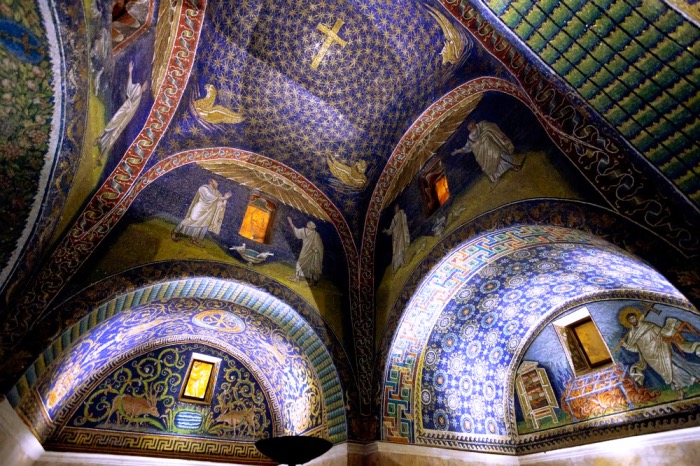
La volta del Mausoleo di Galla Placidia a Ravenna.
THE DOME OF THE MAUSOLEUM OF GALLA PLACIDIA
The dome of Galla Placidia’s mausoleum is one of the must-see works of art in Ravenna as it is decorated with a mosaic of blue and gold tiles, forming a golden cross in the centre and concentric circles of stars expanding to the outer part, where the symbols of the four evangelists are located.
The dome rests on a square, symbolising the Earth, while the mediation between the human and the divine is entrusted to the four evangelists.
THE DOME OF THE BASILICA OF SAINT SOFIA
The enormous dome of the Hagia Sophia in Istanbul was built as a symbol of the vault of heaven and the power of the emperor. The basilica is famous for the light effects that penetrate the interior of the building through 40 windows and create the feeling of being in a mystical environment. The Basilica was built at the behest of Justinian in the 6th century, but after the Ottoman conquest of Constantinople it became the model for many domed mosques.
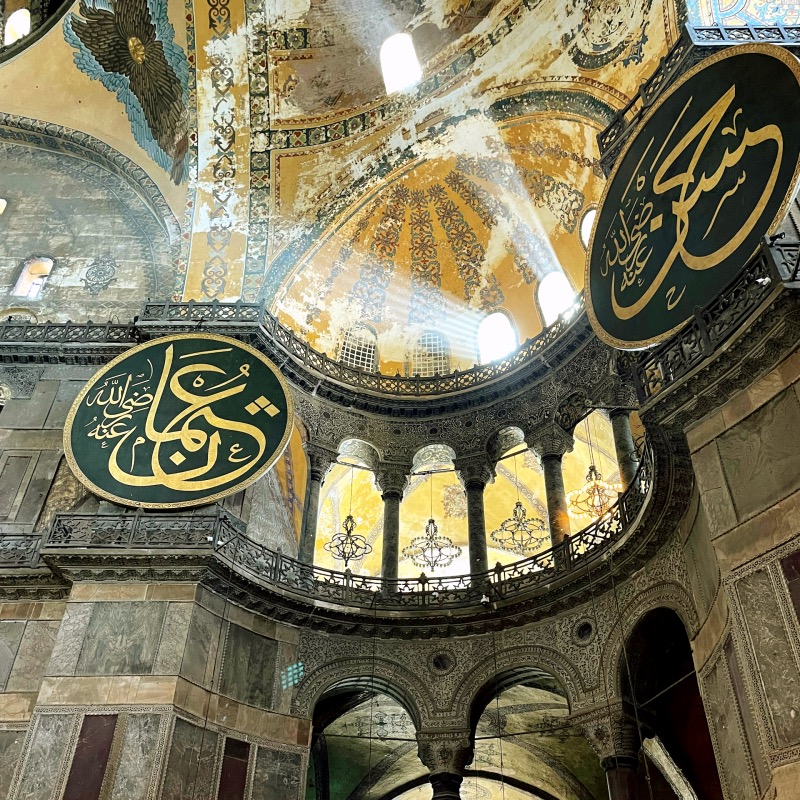
cupola Santa Sofia
THE DOME OF THE BASILICA OF ASSISI
The Upper Basilica in Assisi has a single nave covered by cross vaults painted blue and quilted with gold stars, following a fashion that was very common in medieval churches and which was also the decoration of the Sistine Chapel before the arrival of Michelangelo Buonarroti.
It was a very simple but effective type of decoration, which immediately gave the idea that the ceiling did not exist and that there was the possibility of direct communication with the Kingdom of Heaven.
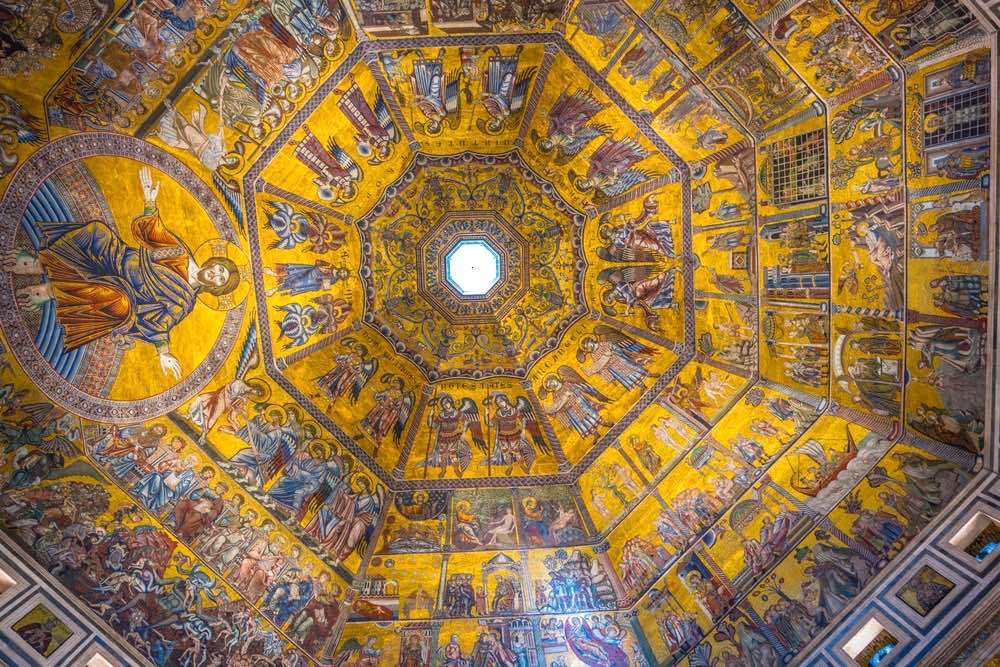
Cupola Battistero di San Giovanni a Firenze
THE DOME OF THE BAPTISTERY OF SAN GIOVANNI IN FLORENCE
The dome of the Baptistery of San Giovanni in Florence is completely gilded and covered with mosaics depicting stories from the Old and New Testaments arranged within concentric rings or octagonals. The sequence of mosaics is interrupted only by the monumental figure of Christ the Judge, while to his left is the representation of hell dominated by the figure of Lucifer.
At the top the angels and archangels look real and create a mystical atmosphere that, combined with the details of their clothes and faces, conveys the feeling of being in front of a divine beauty.
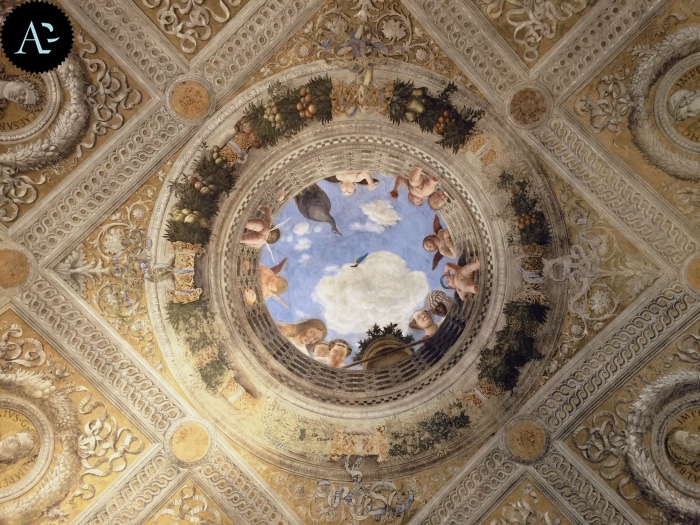
Camera degli Sposi
THE BRIDE AND GROOM’S ROOM IN MANTUA
Andrea Mantegna places an oculus similar to the Pantheon in Rome in the Bridal Chamber in Mantua. In the midst of the Renaissance, therefore, the famous Roman dome is celebrated inside a building that is not religious and not intended for spirituality, as the Bridal Chamber is a state room located inside the castle of San Giorgio in Mantua.
The vault is characterised by a lowered ceiling divided into painted sails and pendentives, with an opening to the sky consisting of a circular aperture to which a lady and her servant, a group of maids, a dozen putti and a peacock look out. the scene is amusing and all these characters are observing the spectators from above.
Visiting the Bridal Chamber in Mantua means admiring the technical virtuosity of Andrea Mantegna, who demonstrated his talent with some very difficult foreshortenings.

CUPOLA DELLA SACRESTIA VECCHIA IN SAN LORENZO A FIRENZE
THE DOME OF THE OLD SACRISTY IN SAN LORENZO IN FLORENCE
The vault depicting the sky and constellations over the city of Florence on the night of 4 July 1442 is probably one of the most beautiful visions in the history of art. The decoration of the small dome of the Old Sacristy in San Lorenzo in Florence describes the signs of the zodiac indicated by the astronomer Paolo dal Pozzo Toscanelli.
It is a description of a real sky, observed above Florence on a very precise date in the Julian calendar and corresponding to our 14 July (of the Gregorian calendar).
According to tradition, that date corresponds to a very important political event, i.e. the arrival in Florence of Renato D’Angiò, who wanted an alliance with Florence after being driven out of the kingdom of Naples by Alfonso of Aragon.
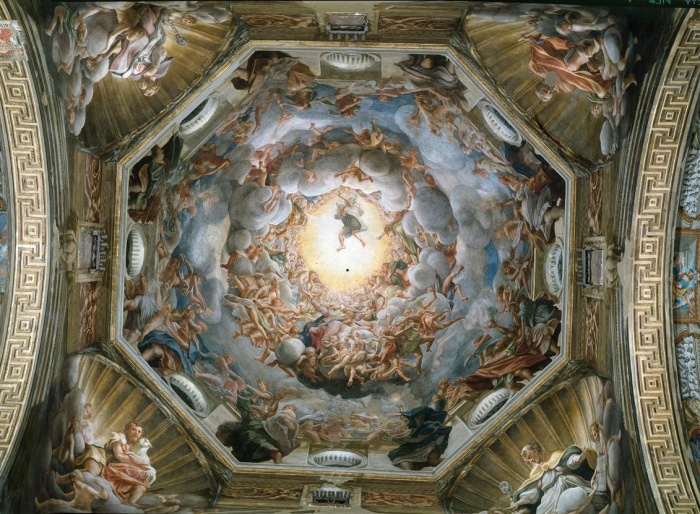
La cupola del Duomo di Parma, dove Correggio dipinge il tema dell’Assunzione della Vergine e trasforma la cupola in un vortice di angeli, di Santi e di Padri della Chiesa.
THE DOME OF THE CATHEDRAL OF PARMA
The Assumption of the Virgin in the dome of Parma Cathedral was frescoed by Correggio in 1530 and is one of the masterpieces to be seen in Parma. it is a spectacular vision in which Mary is seen being carried up to heaven by a vortex of clouds and angels, who seem to be swimming in the air. at the top of the dome, the backdrop of a dazzling golden light makes us notice the presence of Jesus who seems to be going to meet his mother. The technical virtuosity used by Correggio gives us the feeling that the church really opens up to an otherworldly dimension.
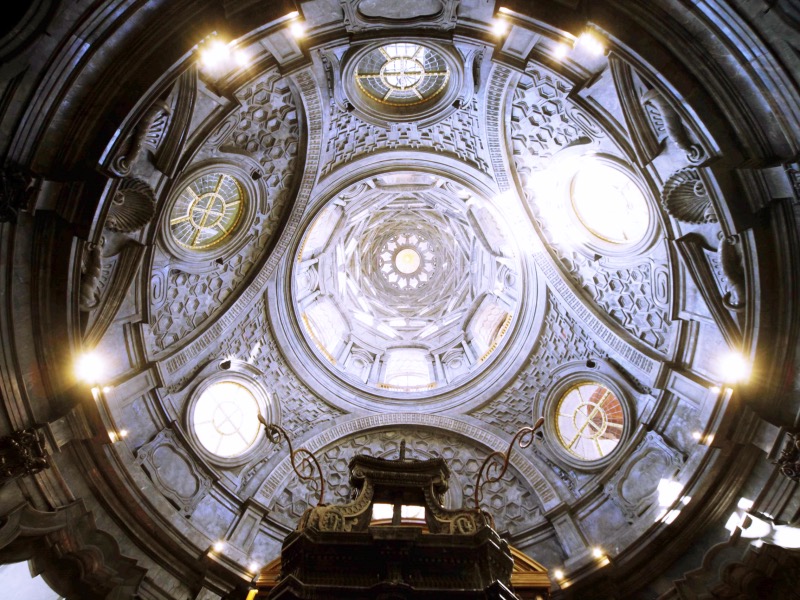
Cupola Sacra Sindone Guarino Giarini Torino
THE DOME IN THE CHAPEL OF THE HOLY SHROUD
The dome designed by Guarino Guarini for the Chapel of the Holy Shroud in Turin is an architectural spectacle consisting of six overlapping arches, making the structure resemble an inverted basket, which at its end places a 12-pointed star that seems to be suspended in the air.
Looking up to the sky, the visitor has the sensation of standing in front of a portal that projects directly into infinity. The light filtering from above appears to be an emanation of divinity, capable of delivering important messages to our souls.
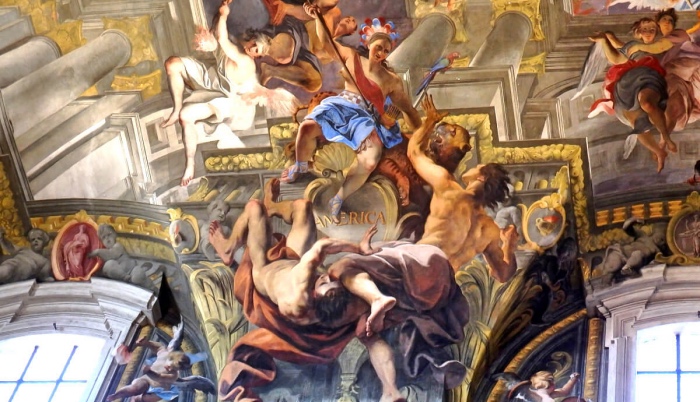
Dettaglio affresco Chiesa Sant’Ignazio di Andrea Pozzo
THE VAULT OF THE CHURCH OF SAINT IGNATIUS IN ROME
The painter Andrea Pozzo celebrates the figure of Saint Ignatius of Loyola in the vault of the Roman church dedicated to the saint, founder of the Jesuit order. And thanks to a spectacular decorative feat, the artist offers us the illusion of admiring Paradise and the Saint’s glory. Andrea Pozzo takes it to the extreme expressive possibilities and uses some experimental technical devices to create the masterpiece of the vault of the Sant’Ignazio Church.
The height of the church seems to be doubled, and looking up, one has the impression that the angels and saints are really flying in space and above the tiles of the faithful. Truly the vault of St Ignatius Church Rome is a gateway between Earth and Paradise.
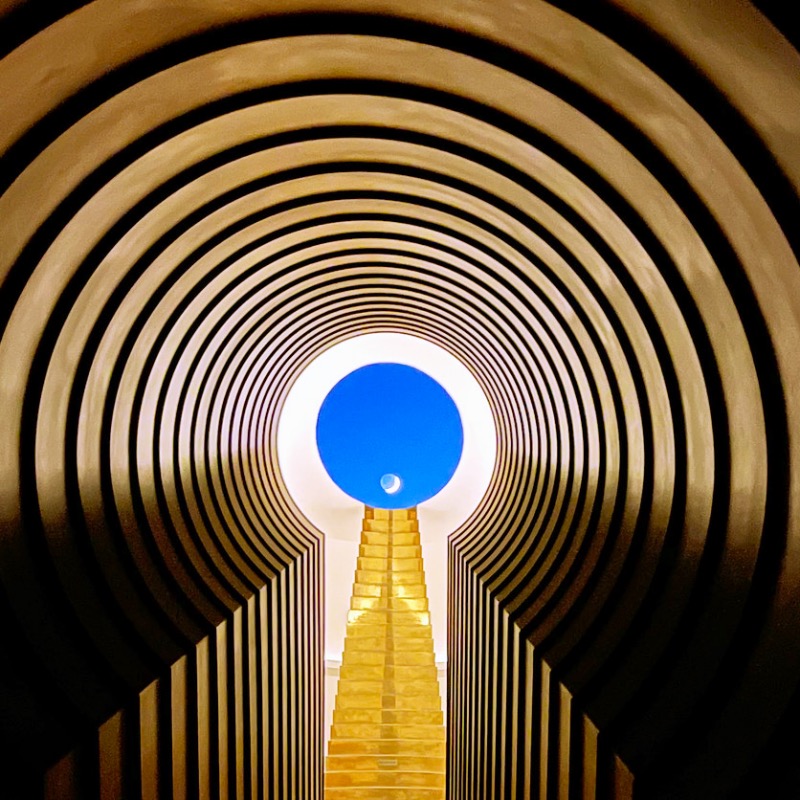
RODEN CRATER PROJECT
RODEN CRATER PROJECT
If we think that spectacular domes are just an example from the past, we are wrong. In fact, even in recent times, spaces have been created that stimulate the sensibilities of contemporary audiences. The American James Turrell has taken the solutions of artists who preceded him centuries earlier to extremes, creating a monumental installation that brings the sky inside a room.
By making openings of different geometric shapes in as many rooms in an extinct volcano in the Arizona desert, the artist compresses the infinite vastness of the cosmos into the tangible space of human experience. The perception of standing in front of the vault of heaven is thus transformed into a spiritual experience, placing the viewer at the centre of the work, in a dialogue with light and the universe.
You can admire the work via the websiterodencrater.com, specially created, but it is the physical presence of the spectator that makes the difference.

